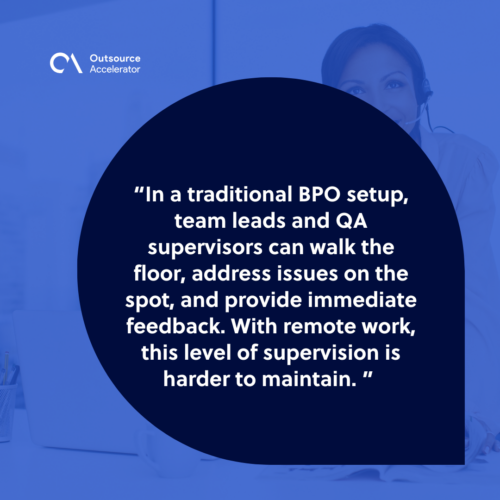Steering through remote work challenges in the BPO industry

The Business Process Outsourcing (BPO) industry thrives on efficiency, consistency, and real-time communication. When the pandemic forced a rapid shift to remote work, BPO firms were among the first to face significant operational hurdles.
The traditional on-site model—once viewed as essential for quality control and client assurance—had to evolve almost overnight.
The approach continues to reshape service delivery models. BPO companies are learning to navigate remote work challenges and develop sustainable solutions.
In the 538th episode of the Outsource Accelerator Podcast, Shahzad Yaqoob, Founder and CEO of IdeasUnlimited, touches upon the remote work challenges his company has had to face.
Rise of remote work in the BPO industry
Even before COVID-19, some BPO providers were experimenting with flexible work environments, particularly for non-voice or back-office functions. However, the pandemic accelerated this shift dramatically.
Companies were compelled to implement work-from-home (WFH) setups to maintain business continuity.

IdeasUnlimited was one of those that were prepared, as Shahzad relates.
“We were already working remotely since 2010. So we had a remote structure in place. We already had all the SLAs and the SOPs and the processes and all that for remote work.”
Remote work became more than a temporary fix. It introduced new cost efficiencies, expanded talent pools, and created flexibility for employees.
Despite its benefits, a number of remote work challenges persisted. The transition exposed operational gaps and required a fundamental rethinking of infrastructure, management, and performance models.
5 Key remote work challenges in BPO
Here are the key remote work challenges that BPO companies encounter.
1. Infrastructure limitations and connectivity issues
A robust technical setup is non-negotiable in the BPO industry, where agents often handle sensitive client data and real-time transactions.
However, remote workers may not have access to high-speed, stable internet connections. This may be particularly true in developing countries where many BPOs are based.
Power interruptions, low bandwidth, and outdated personal hardware often lead to delays and disruptions. These issues directly affect service levels, call quality, and overall productivity, which can damage client relationships if not addressed promptly.
2. Data security and compliance risks
Remote work raises serious concerns around data privacy and regulatory compliance. BPOs handle sensitive information across industries such as finance, healthcare, and e-commerce.
Ensuring that agents adhere to data handling protocols outside a controlled office environment is a significant challenge.
The risk of data leakage, phishing attacks, and non-compliance with international standards like GDPR or HIPAA increases when employees work from unsecured personal devices or networks. Clients may demand added assurances or audits to maintain trust.
Shahzad called this “earlier startup challenges.”
“We were developing our SLAs, our processes, so there were a lot of gaps in that.”
3. Lack of real-time supervision and support
In a traditional BPO setup, team leads and QA supervisors can walk the floor, address issues on the spot, and provide immediate feedback. With remote work, this level of supervision is harder to maintain.
Delays in communication, lack of visual cues, and dependence on digital tools can result in performance gaps going unnoticed.
New hires or struggling agents may not receive the timely coaching they need, which could compromise quality standards and agent retention.
Shahzad also ran into trouble with this.
“We had remote teams, so at times people were in one part of the world, the other was in the other part of the world. You had to make sure that they all log in, get their work done, and log out on time.”

4. Decline in team cohesion and morale
Culture is often the invisible glue that holds BPO teams together, especially in high-pressure environments. Remote work can isolate agents from their peers, reducing the sense of belonging that often fuels motivation and loyalty.
Without informal interactions, group huddles, or office events, many employees report lower morale and higher disengagement. This can increase turnover, especially among younger or entry-level staff who rely on peer support and team dynamics to thrive.
5. Performance monitoring and accountability
While some digital tools allow for time tracking and KPI monitoring, evaluating agent performance in a remote setting is still complex. Metrics like average handling time (AHT), first-call resolution, and customer satisfaction scores need to be captured consistently.
However, distinguishing between technical issues (e.g., poor call quality due to internet lag) and performance issues becomes murky.
Some companies overcompensate by over-monitoring, leading to employee dissatisfaction and a lack of trust.
Strategies to overcome remote work challenges
Here are a number of tips that can help you manage common remote work challenges:
1. Invest in purpose-built infrastructure
Rather than relying on agents’ home equipment, some BPOs have begun offering work-from-home kits that include pre-configured laptops, noise-cancelling headsets, and portable Wi-Fi devices.
Others partner with telecom providers to subsidize internet upgrades for employees.
More advanced solutions include virtual desktop infrastructure (VDI) and secure cloud environments that allow agents to access all systems remotely without compromising data integrity.
These investments not only improve performance but also strengthen compliance.
2. Redesign employee engagement and training programs
Remote doesn’t have to mean disconnected. High-performing BPOs are reshaping engagement strategies with virtual town halls, online recognition platforms, and gamified team activities.
Training modules have also evolved—moving from classroom-style instruction to interactive e-learning platforms with real-time feedback loops.
Mentorship programs and virtual “buddy systems” can replicate the support structures found in physical offices, ensuring new hires feel guided and included from day one.
3. Adopt intelligent performance management tools
Modern workforce management tools powered by AI and analytics can provide deeper insights into remote agent performance. These platforms don’t just track logins—they analyze call sentiment, flag unusual behavior patterns, and suggest tailored coaching interventions.
Rather than relying on blanket productivity reports, managers can use these insights to offer personalized feedback and development plans. This promotes accountability while supporting individual growth.
The future of remote work in BPO
Remote work is no longer a stopgap—it’s a strategic advantage. Many BPO companies are shifting toward hybrid models that blend the benefits of remote and on-site work.
This approach allows for operational resilience, greater access to specialized talent, and more flexible staffing options across time zones.
Shahzad is proud to have overcome those humps, now finding opportunities further down the road.
“The challenges now are completely different. It’s more about finding growth.”
However, the future of remote work in BPO depends on continued innovation.
Firms must build digital-first cultures, reimagine leadership roles, and align their remote strategies with long-term client expectations. The organizations that adapt most effectively will not just survive—they will redefine the next generation of BPO services.







 Independent
Independent




